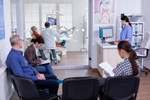What’s in your OHE toolkit?
Published: 12/10/2020
Frances Robinson offers a three-step guide to ensuring patient compliance at every appointment – whatever their age!
How key is a dental nurse in the oral health education of patients?
Dental nurses are a key component of oral hygiene education; they can help choose appropriate oral hygiene aids and explain effective techniques when using them. They can also raise awareness of links between oral and systemic health and inform on wider dental topics, such as the importance of fluoride.
How important is it to have a dental nurse assisting you?
I have only just started working with a dental nurse again since qualifying five years ago and I can honestly say it is absolutely wonderful! This is such a positive to come from the coronavirus crisis as two of the dentists I work for have now provided me with assistance. From a clinical viewpoint, the patient receives more streamlined and efficient care and the clinician can spend more time treating the patient. Help with aspiration is invaluable! Previously I was bending myself into a pretzel! From a motivational and emotional standpoint, I am far happier working with a dental nurse – there is always someone there to discuss cases and treatment approaches.
What can dental nurses do to help raise awareness of good oral health?
Dental nurses have such an important role in awareness and promotion – both chairside and in the wider practice community. They are invaluable in helping with demonstrations (another pair of hands!) and product advice and ideas. They can also be integral in planning practice events to mark National Smile Month or any mouth cancer awareness campaigns, for example.
In this ‘new normal’, should DCPs reach out and make at-home recommendations using social media, website blogs and so on?
Absolutely –now is the time more than ever! I started my Instagram page during the early stages of lockdown after feeling helpless when we told to cease our clinical work. I felt that patients would be missing out on much-needed oral hygiene advice and motivation. One of the dentists I work for promoted my page to patients phoning for such advice, which was fantastic. I think social media has the ability to reach new audiences – even if your followers are well informed on oral health issues, they may take something from your posts and pass it on. For example, being more aware of oral health issues facing the elderly is especially topical.
Is it more important than ever to keep patients on track and recommend homecare protocols and products?
Patients are sometimes tempted by new products on the shelves, such as expensive gadgets and various DIY dentistry kits and, unfortunately, this has only increased during the pandemic. They vary from the useless to the downright dangerous. Whitening toothpastes and charcoal products are trending at the moment – they may remove some surface stains but, ultimately, will become overly abrasive on the enamel. They will never be able to replicate the main pillars of home care – effective toothbrushing often with an electric toothbrush, interdental cleaning and limitation of dietary sugars. Scalers purchased online can damage the gums and cause trauma to soft tissues in untrained hands whilst at-home whitening kits can cause burns and irritation.
I recommend products and protocols by working closely with the patient’s expectations, motivation levels and presence of oral diseases; it’s a team approach that requires nurturing and sometimes multiple stages with regular reviews. With people more interested in their health than ever before, we have an even greater opportunity to educate patients on the links between oral and systemic diseases. Research by my friend and colleague Dr Victoria Sampson highlights the relationship between poor oral health and complications from COVID-19.
How can dental teams tailor advice regarding over-the-counter products?
Listen to the needs of the patients and ask questions in the appointments, such as ‘do you think this is something you would be able to incorporate in to your routine?’ or ‘what would you like to achieve before our next session?’
In further appointments, review what you recommended. For example, if someone really struggled with bending the TePes, we could look at more robust alternatives, such as the ‘easy picks’, the contra-angled ones or the Curaprox range. Furthermore, biodegradable options and eco-friendly alternatives are very popular, so I suggest familiarising yourself with the different brands so you are well placed to recommend products if this concerns someone.
What are the ‘must have’ qualities when communicating recommendations?
Patience goes a long way. I think we can forget working in this profession how good our manual dexterity is! I floss every patient I see but, when I watch them do it back, it makes me realise how well practised we are. The things that come naturally to us may not come so easily for others and if you come across condescending a patient may not feel encouraged. Eye contact, body language and tone of voice are all tools of effective communication. Asking questions about their home set-up and existing routines can be very insightful and make someone feel more involved in the decision-making process. Also, humour can go a long way. I like to have down-to-earth conversations, including anecdotes from my own experiences, which I think helps people relax. For example, with a young orthodontic patient, I might say ‘I know its daunting when you first get braces but I found when I had mine on *this* really helped’ or with a young adult, ‘I use these single-tufted brushes around my own wisdom teeth’.
What are your favourite in-the-chair tools of the trade regarding oral health care?
This is an easy answer – the Oral-B Test Drive! It is so important to see what a patient is doing at home in order to improve technique. For the under brushers and over brushers the correct pressure is a learning curve. For the ones that do a “quick go round” the timings and methodical technique is an education.
In terms of additional products, super floss is fantastic around implants, crowns and bridges. It takes a bit of practice and patience chairside to get the hang of it, but yields brilliant results. Additionally, I love a single -tufted brush. They are so versatile and I use them for periodontal pockets, wisdom teeth and around orthodontic appliances.
Tips from cradle to grey...
Elderly
Good oral health is important for a good quality of life. It’s integral for communicating, socialising and eating. But elderly people suffer a high burden of oral diseases due to increased risk factors and lack of access to dental care. These risk factors include a diet higher in carbohydrates, increased plaque levels, decreased dexterity, reduced saliva secretions and use of some medications. In a study by Age Concern, just over half of older people are registered with an NHS dentist and this decreases with age. Dental decay is a major threat for tooth loss in the elderly; up to 96% of this age group have dental decay and it accounts for up to 60% of dental extractions. Furthermore, untreated dental problems can lead to diseases and infections especially in older people, for example: diabetes, leukaemia, cancers, heart disease and kidney disease, as well as pneumonia. This message is especially important at this difficult time with the coronavirus pandemic as research by my friend and colleague
@drvictoriasampson highlights the relationship between poor oral health and complications from COVID-19. We need to highlight the need for better oral health care provisions for the elderly, both in our own families and society as a whole!
How important is it to involve carers/family in the OHE of elderly patients?
Involving carers and family is integral to improving the oral health of the elderly population. It has to be a conversation including everyone to be effective. Elderly people are often fiercely independent and may take offence to someone trying to take their autonomy. There also seems to be this dissonance between the health of the mouth and rest of the body. I always explain the mouth to be the gateway and make an effort to link systemic conditions to poor oral health – many people are not aware of these. These conditions include diabetes, heart disease, Alzheimer’s and various cancers.
What products do you recommend for at-home oral health care?
Electric toothbrushes are great if they can be tolerated. They get far more strokes per minute than we could ever achieve with a manual brush so it is easier to get a better clean. If someone has xerostomia, pemphigus, is undergoing radiotherapy or another condition that can irritate the soft tissues, I will suggest a softer manual brush (Curaprox) with a high fluoride toothpaste (Duraphat).
I love single tufted brushes because they have a normal toothbrush handle so can be easier to use in hard to reach areas.
What do you recommend for the elderly regarding hydration and diet?
Sipping of water regularly can help alleviate symptoms of xerostomia as well as sucking on ice chips. Consumption of squash and juice should be restricted to meal times. If the mucosa is very sore, moist sticks can prevent the soft tissues becoming sticky or even a small spray bottle of water.
Often, elderly people will need to drink food replacement drinks to help gain weight, which can be very high in dietary carbohydrates. I suggest drinking these in one go rather than sipping on them to reduce frequency of acid attacks on the teeth. The use of straws can also help. The Adult Dental Survey reveals that the effects of poorer oral health disproportionately affect some parts of this population – most notably, older people and those living in the more deprived areas of England. Around two-thirds of participants aged 85 years and older did not have a functional dentition (www.gov.uk/government/collections/oral-health)
Any tips on how to overcome the challenges regarding dexterity?
Insulator piping on toothbrush handles works well or pushing the end into a tennis ball! Having a surface to rest an arm on can help to steady someone with muscle weakness, suffering with Parkinson’s disease or MS. Where shaking is common, even just sitting down can help. Sports racket grip wrapped around oral hygiene aids can help texturise handles so they are easier to hold.Floss harps and interdental brushes are often easier to use than string floss.
Busy adults
How do you change habits of a lifetime?
By incorporating it into existing routines with visualisation techniques. Ask patients: ‘When do you think you will be able to fit it in?’Even if they floss in the shower, it’s better than not doing it! Reminders via an alarm near bedtime or a Post-it note on the mirror can be useful triggers. Extra motivation can also help also. For example, with adults undergoing cosmetic dental treatments or orthodontics, I stress the work will last longer if the foundations of the teeth are healthy!
How long can this take?
Psychologists say it takes 21 days to form a habit. This can be quite daunting to someone trying to make big changes, so I tend to break it down into smaller chunks. We could start with suggesting a daily change for a week at a time or three times a week over a longer period of time. I tend to see unstable patients with shorter recalls in a few weeks to see how they are getting on and to progress to the next level of change. Someone who isn’t a regular brusher isn’t suddenly going to start using an electric toothbrush for two minutes twice a day and floss effectively, so we have to be realistic and scale up changes at each appointment. An extra motivation can help, such as highlighting improved aesthetics of the teeth with better homecare.
During my MSc in dental public health, I had a few lectures with Dr Tim Newton, Professor of Psychology as Applied to Dentistry at King’s College London Faculty of Dentistry, Oral & Craniofacial Sciences.
They were very enlightening in terms of sustained behaviour change. They focused on breaking down the barriers patients often put up and how to work realistically.
What at-home tips do you offer?
I sometimes write out a personal plan with a tick list of activities for am and pm routines. I have also started emailing patients at the end of the session with summary notes, highlighting what I have suggested so they have something to refer back to.
Digital apps are popular now, such as the Oral-B app that shows you how long to spend on each area. If a patient uses it, they can give me access and I can analyse the data at a future appointment.
Children
How important is it to get children into early good oral health habits?
It is immeasurably important to get children into good oral health habits as soon as possible. The disease in the deciduous dentition can affect the adult teeth coming through. Moreover good brushing habits, low sugar diet and limited snacking sets up a child for a health future in oral and general health.
What age should children begin seeing a dentist/hygienist?
They should start seeing the dentist as soon as their deciduous teeth come through to check that they are properly formed and coming through in the correct order. I think they should start seeing the hygienist when they start brushing themselves or if the parent/carer is struggling to brush with them at home. A hygienist appointment is a great way to introduce a child to a positive experience in the dental chair. I always make it fun and interactive.
Research from Oral-B has shown that 70% of parents say ensuring their children regularly pick up a toothbrush is the most stressful element of modern parenting.
How important is getting the key oral health messages across to parents?
It is so important for parent and carers to be on board – the adult will be the one to bring the child to an appointment so they need to be keen on oral health messages.
Moreover, I think dentistry and our knowledge of health has changed so much in short space of time. A parent might not be aware of what hygienists and dentists can do for a child, such as oral health education, fissure sealants, fluoride varnishes and diet advice. I never went to the hygienist as a child, which was shocking actually as I had orthodontics so really could have benefited from it – but it was never offered! I always chat to parents and expectant mothers to explain oral health advice for little ones and guide them to good reputable resources.
How do you make appointments fun for kids and stress free for parents?
I always try to talk to the child as much as possible. Usually the parent listens in but the child is key to win over! Building a relationship with them is so important in terms of trust. Children remember so much. I remember my lovely family dentist who was always so chatty and friendly. He always talked about school or my hobbies first and, in later years, encouraged me to pursue my career in dentistry. Sometimes children can be shy at first so getting them chatting about non-dental things is a great technique to get them to settle in.
I explain every step I’m doing so there are no surprises when I am treating them. If they need to watch in a mirror as well then Ido that, too. Explaining things in fun ways like say the polishing cup is a buzzy bee, or ‘polishing’ their finger nail first, eases in more complex stages of the treatment. Visual aids are a great assistance like disclosing tablets or for really little ones, I use a soft toy with big teeth to play with! Towards the end of the appointment I include the parent in what I have suggested; sometimes I write down recommendations or give out leaflets, and I explain to them if there are certain things they might need to do like helping with brushing. Something I see frequently is the parent leaving the brushing to the child when they 'are able' to do it – realistically, they are probably still too little to have advanced dexterity skills to get all the teeth effectively! I usually suggest the child goes first and then the parent helps go over again afterwards.
How do you motivate younger patients? Any tips to share?
I try to explain oral disease in a way they can understand, talking about ‘bugs’ making the gums ‘sore/angry’ and this helps to reinforce why they need to brush off the plaque. Disclosing tablets once or twice a week are really helpful and can turn it into a game, especially if there are siblings! Sticker charts for brushing with small rewards at the end of the week (rewards picked by the parent) and diet sheets with sugar/snack tracking can identify hidden treats. I recommend the Change4Life app or healthy snack swap apps to see where the diet can improve.
Elderly
Busy adults
Children
|
Author: Frances Robinson








.jpg?width=150&height=100&scale=canvas)




